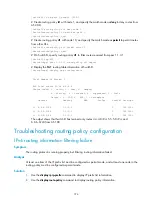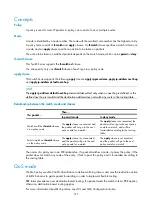
386
<SwitchB> system-view
[SwitchB] ip route-static 10.110.0.0 24 1.1.2.1
# Configure the IP address of VLAN-interface 10.
[SwitchB] interface vlan-interface 10
[SwitchB-Vlan-interface10] ip address 1.1.2.2 255.255.255.0
[SwitchB-Vlan-interface10] quit
3.
Configure Switch C:
# Configure a static route to subnet 10.110.0.0/24.
<SwitchC> system-view
[SwitchC] ip route-static 10.110.0.0 24 1.1.3.1
# Configure the IP address of VLAN-interface 20.
[SwitchC] interface vlan-interface 20
[SwitchC-Vlan-interface20] ip address 1.1.3.2 255.255.255.0
[SwitchC-Vlan-interface20] quit
Verifying the configuration
Configure the IP address of Host A as 10.110.0.20/24, and the gateway as 10.110.0.10.
On Host A, Telnet to Switch B (1.1.2.2) that is directly connected to Switch A. The operation succeeds.
On Host A, Telnet to Switch C (1.1.3.2) that is directly connected to Switch A. The operation fails.
Ping Switch C from Host A. The operation succeeds.
Telnet uses TCP, and ping uses ICMP. The preceding results show that all TCP packets arriving on
VLAN-interface 11 of Switch A are forwarded to next hop 1.1.2.2, and other packets are forwarded via
VLAN-interface 20. The PBR configuration is effective.
IPv4 PBR configuration example (using a QoS policy)
Network requirements
As shown in
, redirect all packets received on GigabitEthernet 1/0/1 of Switch A to the next
hop 202.1.1.2.
Figure 125
Network diagram
Configuration procedure
# Configure ACL 2000.
<SwitchA> system-view
[SwitchA] acl number 2000















































